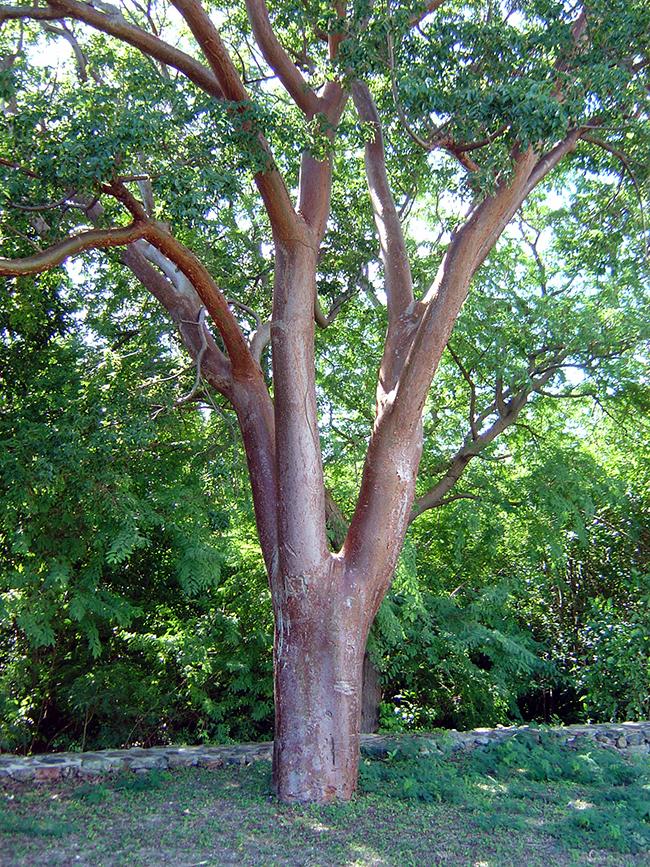What comes to mind when you hear the term cypress dome? How about slough slog or wet walk? Visit Everglades National Park in southern Florida, and you’ll learn a whole new terminology set.

Gumbo limbo (aka the tourist tree) is a common sight at Everglades National Park / NPS-Dan Clark
Anole (Ah-no-lay) – A small lizard prevalent in the park. Sometimes referred to as a chameleon because it can change color from bright green to brown to gray to blend in with its environment.
Backwater – A part of a river in which there is little or no current.
Bladderwort - A carnivorous water plant with small yellow flowers. It has small bladders below the water's surface to trap small animals.
Bromeliad (bro-mee-lee-ad) – Flowering plants belonging to the pineapple family (Bromeliaceae) native to tropical North and South America. These include both epiphytes (non-parasitic plants that grow on other plants) like cardinal airplant (Tillandsia fasciculata) and terrestrial species that take root in the ground, such as the pineapple (Ananas comosus).
Buttress Trunk - a tree trunk that is wide at its base, like a cypress tree.
Cypress Dome – We might typically think of this as a dome-shaped hill, but a cypress dome is a water-filled depression in which stand a cluster of cypress trees. The deepest water is at the center of this dome so that is where the trees grow the highest, creating what looks like a dome or hill to us.
Cypress Knees – Rounded, knobby woody projections growing from the roots of cypress trees.
Epiphyte - Any plant that grows on another plant but does not use the host plant for nourishment.
Estuary - The part of a wide, lower course of a river where its current is met and influenced by the sea. An arm of the sea that extends inward to meet the mouth of a river.
Gator Hole – A burrow dug into the wetland by an alligator using its feet, snout, and tail. Typically 10-20 feet (3 – 6.1 meters) in diameter and a foot (0.3 meter) deep, these water-filled depressions provide cool respite to the alligator as well as water for it and other animals during the dry season. They also make for nice feeding grounds for the alligator when other wildlife comes to drink the water in that shallow hole.
Gumbo Limbo – Often called the "tourist tree" because its red, peeling bark looks like a tourist with a bad sunburn, this tree of southern Florida and the American tropics commonly found in hardwood hammocks has a smooth coppery bark and supplies a reddish resin used locally in cements and varnishes. If a limb is cut off and stuck in the ground, it will generate roots and become a tree.
Hammock - Scattered islands of hardwood trees and dense undergrowth which thrive on slightly elevated spots in the Everglades.
Hydroperiod – The duration or timing of flooding in wetlands.
Peat – One of two soil types found in Everglades.
Periphyton - A combination of several algae which form a mat that is a base of the food chain of the fresh waters of the Everglades.
Saline – Water that contains salt, like estuaries or the ocean.
Sea level - the average level of the ocean's surface over a given area
Slough (slew) Slog/Wet Walk – A ranger-led hike through a freshwater channel, swamp, or lake that is a backwater to a larger body of water. There are sawgrass, cypress, and willow sloughs found in the Everglades.
Solution Holes - Pits in karst that formed in the past when sea level and the water table were lower than present levels. Solution holes provide winter dry-season refuge for aquatic animals and provide a repopulation source for species upon reflooding of the marsh during the following summer wet season. Solution holes, as opposed to sinkholes, are depressions which form gradually from ground level down due to decaying vegetation creating weak acids dissolving the limestone bedrock. Sinkholes, on the other hand, form when the ceiling of an underground cavity suddenly collapses.
Storm surge - a sudden rise in the level of ocean water, generally caused by tropical storms / hurricanes and/or strong winds, that can cause flooding
Speaking of slough slogs:
Featured In The Traveler
Wet Feet And Wild Thoughts
At least the water is clear.
This is my first thought as I take one ginger step into a bald cypress forest in Everglades National Park. Instantly, the water is at my ankle. Through the iced-tea colored water, I can still see my shoe—a good sign. So I take another step—now both feet are wet. I steady myself on the uneven, rocky ground beneath my feet and proceed into a bald cypress dome.
To read more of this article, head to this page.
This is just a sampling of terminology you might hear or read upon your own visit to Everglades National Park.

Visitors enjoying a guided slough slog (aka wet walk) at a cypress dome in Everglades National Park / NPS-Anthony Sleiman





